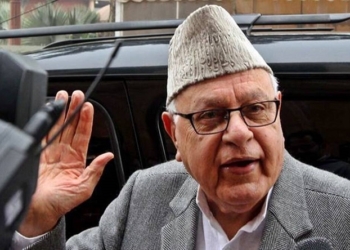
UNDERSTANDING ISIS: The unfurling of the black flags associated with ISIL (Islamic State of Iraq and the Levant) or ISIS (Islamic State of Iraq and Syria), mostly at funerals of youth killed in encounters, is a phenomenon that was introduced in Kashmir back in 2016. The trend has continued off and on with masked men unfurling black flags during protests, and now even at the pulpit, as in the latest case of violation of sacred space of the historic Jamia Masjid. Such actions have sparked an intense curiosity amongst the masses about who is behind such actions and what are the motives and intentions of people behind such acts.
Some are enamoured by the atavistic goals of ISIS, the reclamation of the Caliphate, and others wary of how Islam is being hijacked by those that may not even understand the intent of their actions. There are discussions around the question whether ISIL or ISIS, a global Jihadi movement has arrived in Kashmir? Even the person who is supposed to lead the ISIS movement in Kashmir is often conflated with a supporter of Al Qaeda, a faction that separated from ISIS early on.
In this very brief write up my hope is to dispel some myths about the roots of ISIS and its relevance or irrelevance in the larger Muslim context and how Muslims around the world have responded to rise of ISIS. My contention is that Kashmiri Muslims, especially religious leaders and others should inform themselves of this amorphous group. In light of the global response of Islamic leaders they should develop their own understanding that takes into consideration the particularities of the situation in Kashmir.
In June of 2014 Abu Bakr al Baghdadi, former Al Qaeda operative declared the creation of a caliphate stretching across parts of Syria and Iraq and proclaimed himself as the caliph. Al Baghdadi insisted that allegiance to this caliphate was a religious obligation on all Muslims, a fact that rightly invited rejection and condemnation from all across the Muslim world. Yet, we have seen in the last four years, shades of adherence to this self-declared caliphate in some parts of the Muslim world, prompting a small fringe of extremists to pay allegiance to Al Baghdadi, uphold his propaganda, and even joining militancy. So what is behind this phenomenon of following a leader and his twisted ideology, especially amongst some Muslim youth? Is it the desire to return to the Golden Age and a yearning for becoming powerful once more on the world stage? Is it a result of Muslims dealing with despondency and despair in recent years? The Islamic state of Al Baghdadi has no resemblance to an ideal popularly elected caliph who is not above the law and who is accountable. Other than imitation of the black robes and black flags of the Abbasid times, there is nothing else in Al Baghdadi or his followers that exhibits an ideal Muslim leader or community, so why the fascination?
To start with, it is important to understand where this group finds its inspiration. Just like Al Qaeda, ISIS finds its inspiration in Wahabbism, a puritanical, anti-intellectual, and extreme view of Islam. There are various elements complicit in the rise of this extremist ideology going back to the Soviet invasion of Afghanistan. As much as the public face of the United States and its allies is fighting the so called war on terror, the fact remains that the United States, Saudi Arabia, and Israel have actively promoted extremist ideology that has led to the rise of groups like Al Qaeda in Afghanistan and ISIS in Iraq and Syria. A new direction and shift in Middle East policy during the second term of George Bush the Jr. occurred when the new target was chosen to be Iran. He and the neocons in his administration and other US allies, namely Saudi Arabia, Israel and other Gulf states, including Turkey, saw Shia Iran as more radical and dangerous than the Sunni extremists. The common interest of Saudis and Israelis and some Gulf states remains the targeting of Iran even today. For Israel, the threat is Irans support of Palestine and for Saudi Arabia and some Gulf states, it is the fear of Iran’s strategic power in the region.
The best warning of what was being planted, and a clear indication of what lay ahead, was Seymour Herschs March 5, 2007, seminal report in the New Yorker, The Redirection: Is the Administration’s new policy benefitting our enemies in the war on terrorism? Hersch documented how Bush Jr. urged Saudi Arabia to actively use sectarianism as a way to undermine Assad regime in Syria and Hezbollah in Lebanon marking a shift from focus on the Soviet Union and communist forces, to Iran. In 2014, When it became obvious that Baghdad was being threatened by ISIS, it was revealed that allies of the US, wealthy donors of Kuwait , Qatar, and Saudi Arabia had been funding ISIS for years, fomenting the sectarian divide. The goal was never the publicized mantra of stability of the Middle East, rather destabilizing Iran and Assads Syria, an effort fully supported by Israel’s secret program to back Syrian rebels. Existence of this program was further affirmed by the recent admission of the outgoing chief of the Israeli Defense Forces. While the United States was also involved in training and arming the rebels, a declassified US intelligence report of August 2012 shows a silent approval for the creation of the Islamic state as a counter force to the Syria.
While the West and its allies have historically used abuse of Islam to serve its colonial projects to maintain their hegemony, the reality is that majority of Muslims have rejected this extremist ideology. As per Pewforum global survey of Muslims, extremism is widely rejected by Muslims around the world. Prof. Kurzman in his book The Missing Martyrs: Why there are so few Muslim terrorists concludes that Muslims dont approve of Al Qaeda or ISIS as genuine and legitimate forms of resistance to western hegemony, or as a challenge to dictators in the Middle East. Support and funding of groups like Al Qaeda, especially its leader, Bin Laden, by the Saudi regime is also well documented. The United States was responsible for the creation of Al Qaeda, something even admitted by the former US Secretary of state, Hilary Clinton. As revealed by a powerful expose of a top commander of ISIS, the top brass leadership of ISIS, including Abu Bakr Al Baghdadi, was also cultivated under the noses of American jailers in an America prison, particularly, camp Bucca.
All these details are important to bear in mind as we understand the death and destruction in Iraq and Syria and displacement of millions of Iraqis and Syrians and the alarming sectarianism that was nonexistent in Syria and Iraq prior to external intervention.
So the question one wonders about is, what changed as far as the western attitude and support of ISIS and why? How is it that a group of insurgents that they created and supported, suddenly became the targets to eliminate, or so they claim. This story of a friend and ally turning into an enemy bears stark resemblance to a previous story of a friend and ally of the western powers, Saddam Hussein. Awful atrocities and murders and posting these atrocities online is when the west could no longer stay quiet about murderous aims of ISIS. The monster they created had started to turn on their own interests by attacking minorities and foreign journalists and aid workers. Saddam became the Hitler of Iraq as soon as he stepped into Kuwait. He was an angel in the eyes of the West while he was gassing his own people and engaged in a bloody war with Iran. And there was no hue and cry when ISIS was butchering fellow Muslims, but when the killings were directed at western interests, there was a shift.
Such divide and rule policy of the United States and other allies is nothing new. Repeat interventions in the Middle East have brought nothing but misery, death and destruction to the Middle East. It has kept the Middle East on boil presenting the image of instability where Israel is projected as the only stable force in the Middle East. Therefore, to expect those who created the menace of ISIS also to be saviours of the people of the Middle East and to get rid of extremists hell bent on sectarianism and destruction, is naive.
Idrisa Pandit is the Director of the Studies in Islam program at Renison University College, University of Waterloo.
Follow this link to join our WhatsApp group: Join Now
Be Part of Quality Journalism |
Quality journalism takes a lot of time, money and hard work to produce and despite all the hardships we still do it. Our reporters and editors are working overtime in Kashmir and beyond to cover what you care about, break big stories, and expose injustices that can change lives. Today more people are reading Kashmir Observer than ever, but only a handful are paying while advertising revenues are falling fast. |
| ACT NOW |
| MONTHLY | Rs 100 | |
| YEARLY | Rs 1000 | |
| LIFETIME | Rs 10000 | |








